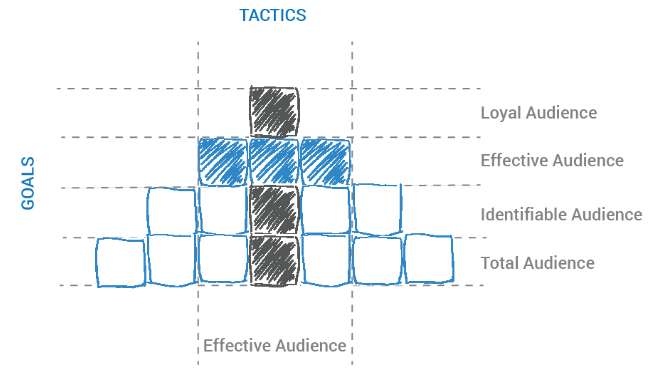
106,859,714
That is the number of copies of Minecraft sold between its launch in 2009 and June this year. Minecraft is a stunningly simple game: you play in a world comprised of building blocks. These blocks take different forms, and the objective is simple: mine for resources and build things with blocks. The simplicity of the system allows for the creation of amazingly complex structures only limited by a player’s imagination.
Much like in Minecraft, Marketing by Building Blocks allows you to create amazingly complex marketing strategies built on the simplicity of your building blocks: the audiences I introduced you to last week.
So now that you have your building blocks, the audiences we defined previously, create a drawing with them stacked on top of each other. Once they are stacked you will see that the audiences flow both horizontally and vertically.
Step 1: Goal Alignment
This is my favorite part. You see when you take the time to figure out your building blocks, you are are defining the easiest pathway to kickstart your growth. The logic is simple, if your effective audience reflects those people that are most likely to take a positive action for you then you know where to focus your efforts.
What to do:
- Articulate your organizational goals.
- Identify the audience that is most likely to support each goal. Pro-tip: certain goals, such as sales, can be broken up among each audience
- Write the goals along the left hand side of your drawing
This process allows you to articulate how each audience will impact the goals.
Step 2: Channel Identification
More of a Step 1(b), channel identification is the process of identifying and articulating ways in which you can communicate to your audiences and the types of communication that they respond to the best. While complex, and requiring a bit of data analysis, this step informs the rest of your strategy.
What to do:
- List out all of the channels that you can use to communicate to each audience
- Record average engagement rates for each channel per audience
At this point you should realize that each audience is not truly independent. Your Loyal Audience is part of your Effective Audience, and so on. This being true should begin to bring clarity on strategy.
Step 3: Tactics
As you are looking into your communication channels and looking at effectiveness, you should start to see patterns of what is working and not working for your audiences. These patterns, along with industry best practices and focused experimentation, can be put together to make up the tactics you will use to get your audiences to make the behavioral changes that support your goals. That is a long winded way of saying, now it is time to figure out how you are going to get your audiences to do things that help you achieve your goals.
What to do:
- Identify the modes of communication that have worked well in the past for each audience.
- Research what others are doing (and how they are doing it) with similar audiences that is working.
- Design rational experiments that incrementally improve upon what has worked in the past. Pro Tip: Make a list of things that did not work in the past; if they seem like the should have worked, design experiments around them as well.
Step 4: The Strategy
Having walked through Step 1 through Step 3 putting together your strategy should be a fairly easy process. Marketing by Building Blocks has the advantage of making strategic planning a result of the process of identification and articulation. Although your marketing strategy is not as simple as the results of the first three steps, it is built upon those results.
The key thing here is to remember that as your audience ascends on your stack, the audiences also descend through the stack. Which means that as you build the strategy to reach and grow your Total Audience you need to customize the tactics for each of your other audiences.
What to do:
- Create a document that explains your goals, your audiences, tactics, and experiments.
- Build out the practical strategies and timelines you will employ.
- Budget out the costs to do so.
- Use all of that to build out a strategic calendar.
The Rub
True to the name, Marketing by Building Blocks helps you create a strategic plan by building off of the identification process. The magic behind this framework is not in the blocks themselves, but in the process of defining your blocks. In order to build your blocks you need to measure and assess what you are currently doing. What is working, what is not working, and why. When you focus on what is really happening within your audience you discover that small incremental changes yield amazing results.
That is the power behind Marketing by Building Blocks.


